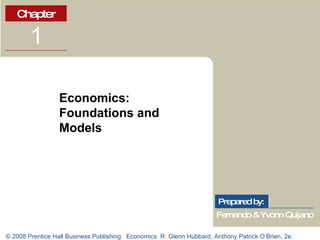
Chap1pp
- 2. What Happens When U.S. High-Technology Firms Move to China? Learning Objectives Many U.S., Japanese, and European firms have been moving the production of goods and services outside their home country … 1.1 Explain these three key economic ideas: People are rational . People respond to incentives . Optimal decisions are made at the margin . 1.2 Discuss how an economy answers these questions: What goods and services will be produced? How will the goods and services be produced? Who will receive the goods and services? 1.3 Understand the role of models in economic analysis. 1.4 Distinguish between microeconomics and macroeconomics . 1.5 Become familiar with important economic terms . APPENDIX Review the use of graphs and formulas .
- 4. Economics: Foundations and Models Scarcity The situation in which unlimited wants exceed the limited resources available to fulfill those wants. Economics The study of the choices people make to attain their goals, given their scarce resources. Economic model A simplified version of reality used to analyze real-world economic situations. 4.1
- 5. Three Key Economic Ideas Market A group of buyers and sellers of a good or service and the institution or arrangement by which they come together to trade. 4.1 Learning Objective 1.1 Throughout this book, as we study how people make choices and interact in markets, we will return to three important ideas: 1 People are rational. 2 People respond to economic incentives. 3 Optimal decisions are made at the margin. Marginal analysis Analysis that involves comparing marginal benefits and marginal costs.
- 17. Microeconomics and Macroeconomics Microeconomics The study of how households and firms make choices, how they interact in markets, and how the government attempts to influence their choices. Learning Objective 1.4 Macroeconomics The study of the economy as a whole, including topics such as inflation, unemployment, and economic growth.
- 19. An Inside LOOK Should the United States Worry about High- Tech Competition from India and China? Nightmare Scenarios
- 20. Allocative efficiency Centrally planned economy Economic model Economic variable Economics Equity Macroeconomics Marginal analysis Market Market economy Microeconomics Mixed economy Normative analysis Opportunity cost Positive analysis Productive efficiency Scarcity Trade-off Voluntary exchange K e y T e r m s
- 22. FIGURE 1A-1 Bar Graphs and Pie Charts Graphs of One Variable Appendix
- 23. FIGURE 1A-2 Time-Series Graphs Graphs of One Variable Appendix
- 24. FIGURE 1A-3 Plotting Price and Quantity Points in a Graph Graphs of Two Variables Appendix
- 25. FIGURE 1A-4 Calculating the Slope of a Line Graphs of Two Variables Slopes of Lines Appendix
- 26. FIGURE 1A-5 Showing Three Variables on a Graph Graphs of Two Variables Taking into Account More Than Two Variables on a Graph Appendix
- 27. FIGURE 1A-6 Graphing the Positive Relationship between Income and Consumption Graphs of Two Variables Positive and Negative Relationships Appendix
- 28. FIGURE 1A-7 Determining Cause and Effect Graphs of Two Variables Determining Cause and Effect Appendix
- 29. Graphs of Two Variables Are Graphs of Economic Relationships Always Straight Lines? The graphs of relationships between two economic variables that we have drawn so far have been straight lines. The relationship between two variables is linear when it can be represented by a straight line. Few economic relationships are actually linear. Appendix
- 30. Graphs of Two Variables Slopes of Nonlinear Curves FIGURE 1A-8 The Slope of a Nonlinear Curve Appendix
- 31. Formulas Formulas for a Percentage Change One important formula is the percentage change. The percentage change is the change in some economic variable, usually from one period to the next, expressed as a percentage. Appendix
- 32. Formulas Formulas for the Areas of a Rectangle and a Triangle FIGURE 1A-9 Showing a Firm’s Total Revenue on a Graph Appendix
- 33. Formulas Formulas for the Areas of a Rectangle and a Triangle FIGURE 1A-10 The Area of a Triangle Appendix
- 34. Formulas Summary of Using Formulas 1 Make sure you understand the economic concept that the formula represents. 2 Make sure you are using the correct formula for the problem you are solving. 3 Make sure that the number you calculate using the formula is economically reasonable. For example, if you are using a formula to calculate a firm’s revenue and your answer is a negative number, you know you made a mistake somewhere. Whenever you must use a formula, you should follow these steps: Appendix